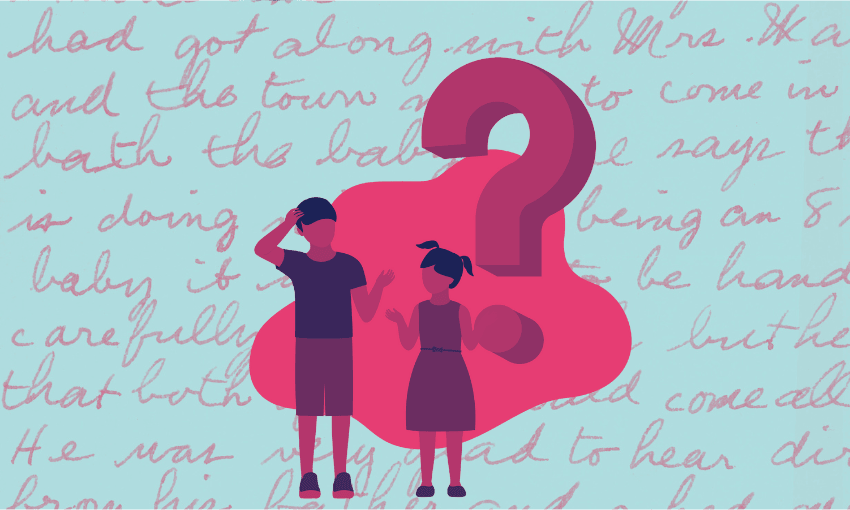As the debate over what should be in New Zealand’s curriculum continues, Shanti Mathias says there’s no point learning to write in cursive if you can’t read it.
I still remember the day I realised I was never going to learn to write in cursive. For my first five years of schooling in the New Zealand education system, I had progressed along the dotted handwriting lines, learning to form “g”s and “k”s and the rest of the letters with the correct proportions. By the time I was 10, I was nearly ready: the workbooks sent from Te Kura – the New Zealand Correspondence School to my family in India began to feature practice letters with little flicks at the end, the first step towards full cursive writing.
I recently discovered this longing in a diary I kept for about three weeks when I was 10. “Soon we are going to learn to write in cursive,” I wrote, in an ugly scrawl, letters all separated, alongside profound insights like “my brother is annoying but I miss him when he’s not here” and “we had eggs for lunch”. When the next school year started a few months later, I was attending a new school with an American curriculum – where cursive writing had been taken off the curriculum standards in 2010. After two days with no classes for practising handwriting, it was obvious: my handwritten letters would remain unjoined. I was never going to learn the secrets of cursive.
I wasn’t the only one who missed out. A decade later, the former president of Harvard University was lamenting in the pages of The Atlantic: “given a current generation of students in which so few can read or write cursive, one cannot assume it will ever again serve as an effective form of communication.”
My 10-year-old self, so eager to write in fluid, looping letters – imagining passionate confessions to diaries, funny little observations passed in notes to friends – would be stoked that in New Zealand, a new Ministerial Advisory Group report has recommended grammar and handwriting lessons, including cursive, for every student in primary schools, to improve academic achievement all round. Some teachers and unionists are sceptical, saying the report was written without consulting with the sector and more achievement standards won’t necessarily create a better curriculum.
But never mind that: my question is, what’s the point of learning to write cursive if you can’t read it? I have somewhat achieved my childhood dream – in that I now have friends who write me letters – but these missives are all too often in cursive. As someone who sometimes struggles to decipher even my own handwriting, I think calls for handwriting classes don’t go for enough. Everyone’s writing is a little different, and too long have the type of people who draw circles, rather than dots, over their ‘i’s been forced to do all the writing for poster projects or handed the whiteboard marker at work brainstorming sessions. If we’re out here throwing out new ideas for the curriculum – a process which at this point has surely involved dozens of variously qualified working groups and columnists fishing for topics – then why not have a handreading class?
Everyone’s handwriting, no matter how wobbly or loopy or uneven, deserves an equal chance of being read, so why not teach it at schools? This would be great news for all the doctors who haven’t heard about computers yet. Grandads writing birthday cards their grandchildren can barely read would love it. It would be excellent for the historical record, with the population of people who can actually read letters and archival records increasing.
There could be downstream benefits to everyone being better at reading handwriting, too. In 30 years, the lecturers marking handwritten university essays (the only way to guarantee students aren’t using AI by then will presumably be to make them write by hand and putting them in a room with a signal that interferes with internet-connected brain implants) will be grateful for their intermediate school lessons teaching them the difference between a “g” and a “y” written at speed. Students might start passing notes in class again with the certainty that they’ll be comprehended, a double blow to the technology companies who once made millions of dollars from the irrepressible desire to message people from under your desk and the politicians who thought a phone ban would prevent kids from being distracted in class. Graffiti artists will think of even more obscure and avant-garde names once their tags can be consistently read, pushing culture forward. Novelists could trumpet their process of writing in longhand without fearing that they’ll seem elitist.
There’s no point teaching kids to write in cursive if they’re not going to learn to read cursive too. For the sake of all those I’ve listed above, up to and including 10-year-old Shanti, the people behind the new curriculum must keep this in mind. Until then, we’re on our own, whether writing or reading, pens poised in the hope – if not belief – that our words will be understood.

